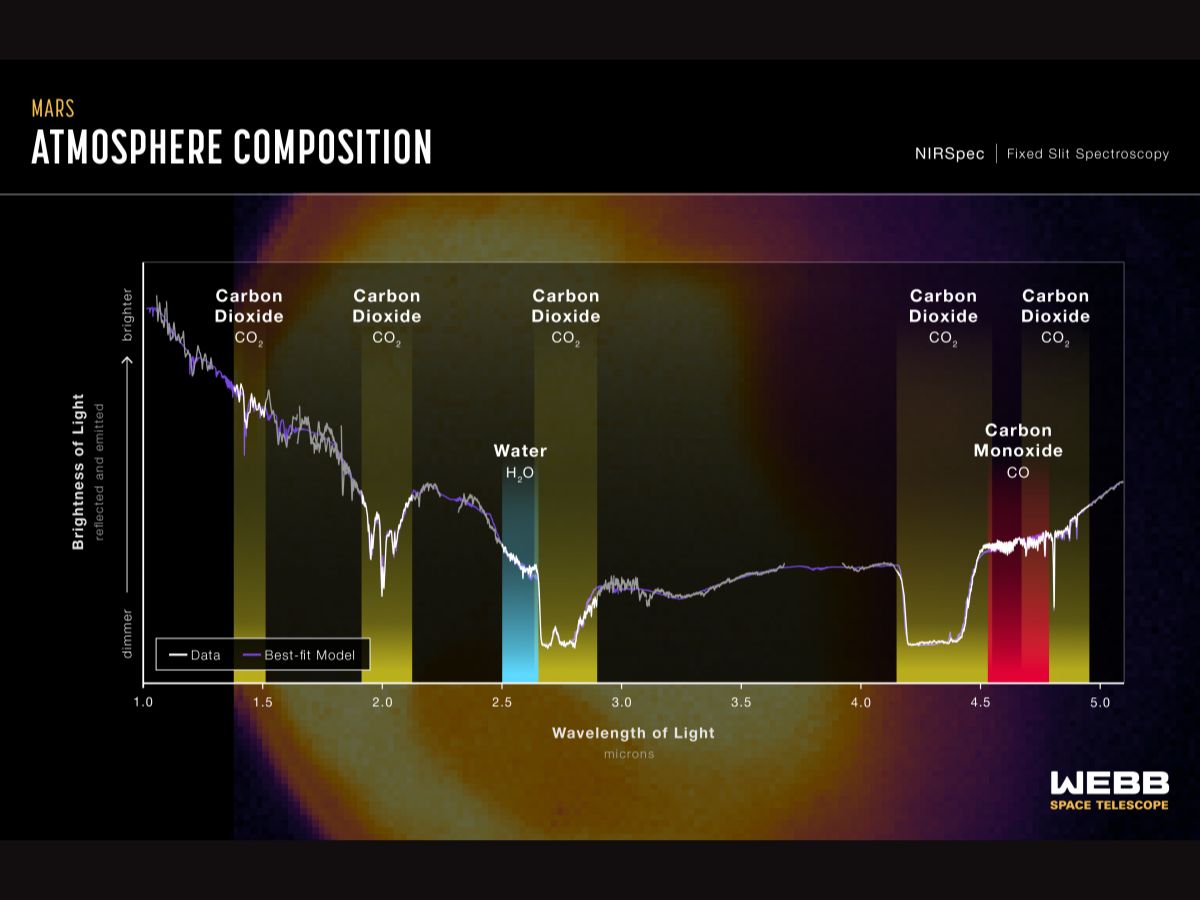James Webb Space Telescope Captures Its First Images Of Mars. Know What They Mean
On September 5, the James Webb Space Telescope, the world's most powerful telescope, captured its first images and spectra of Mars, providing everyone with interesting details about the Red Planet.

NASA's James Webb Space Telescope leaves no stone unturned to leave the world awestruck. Since July, 2022, NASA has been unveiling breathtaking pictures of the cosmos taken by the JWST, also called Webb. On September 5, Webb, the world's most powerful telescope, captured its first images and spectra of Mars, providing everyone with interesting details about the Red Planet. Webb's home, the Sun-Earth Lagrange point 2, is a unique observation post located nearly a million miles away from Mars.
The post provides Webb a view of Mars' observable disk, which is the portion of the sunlit side facing the telescope, as a result of which the observatory can capture images and spectra with the spectral resolution needed to study short-term phenomena like dust storms, seasonal changes, and weather patterns. Using Webb's images, scientists can study, in a single observation, the processes that occur at different times of a Martian day, NASA says on its website.
What Challenges Does Mars Pose To Webb?
Mars is one of the brightest objects in the night sky in terms of both visible light, which human eyes can see, and the infrared light that Webb is designed to detect. Since the observatory is designed to detect the extremely faint light of the most distant galaxies in the universe, the Red Planet being a bright object in terms of infrared light poses special challenges to Webb.
ALSO READ | Listen In: A New, Immersive Way To Explore NASA James Webb Space Telescope Images, With Sound
The telescope's instruments are sensitive and hence, without special observing techniques, the bright infrared light from Mars is blinding. This results in a phenomenon known as "detector saturation".
Astronomers used very short exposures, measured only some of the light that hit the instruments' detectors, and applied data analysis techniques, in order to adjust for the Red Planet's extreme brightness.
ALSO READ | James Webb Space Telescope Unveils 'Never-Before-Seen' Stars In Tarantula Nebula
What Do Webb’s First Images Of Mars Mean?
Webb's Near-Infrared Camera (NIRCam) captured the telescope's first images of Mars. The images show a region of the Red Planet's eastern hemisphere at two different wavelengths, or colours of infrared light.

An image of Mars captured by Webb shows a surface reference map from NASA and Mars Orbiter Laser Altimeter (MOLA) on the left. On the right side, the near-infrared images captured by Webb can be seen.
At the top right, a NIRCam image shows sunlight reflected from Mars, at a brightness of 2.1 microns, and reveals features such as craters and dust layers.
At the bottom right, another NIRCam image, simultaneously captured with the previous one, shows emitted light at a brightness of 4.3 microns. The image reveals temperature differences between latitude and time of days, and the darkening of Hellas Basin caused by atmospheric effects. The bright yellow region seen in the image is just at the saturation limit of the detector.
ALSO READ | NASA's James Webb Space Telescope Captures Its First Image Of An Exoplanet
Therefore, the NIRCam shorter-wavelength (2.1 microns) image is dominated by reflected sunlight. The rings of the Huygens Crater, the dark volcanic rock of Syrtis Major, and the Hellas Basin, can be seen in the image.
The NIRCam longer-wavelength (4.3 microns) image, on the lower right, shows thermal emission, which refers to the light given off by a planet as it loses heat. The brightness of 4.3-micron light is associated with the temperature of the surface and atmosphere. The region on a planet where the Sun is nearly overhead is generally the warmest, and also the brightest.
Since the polar regions receive less sunlight, and less light is emitted from the cooler northern hemisphere, the brightness decreases towards the poles. The Martian northern hemisphere is experiencing winter at this time of the year.
ALSO READ | James Webb Space Telescope Captures Inner Region Of Orion Nebula. See PICS
Why Does Hellas Basin Appear Darker Than Its Surroundings?
Temperature is not the only factor affecting the amount of 4.3-micron light reaching Webb's NIRCam, NASA says on its website. Some of the light emitted by the Red Planet gets observed by carbon-dioxide molecules in the Martian atmosphere. Due to this effect, the Hellas Basin, which is the largest well-preserved impact structure on Mars, and spans more than 1,900 kilometres, appears darker than the surroundings.
ALSO READ | EXPLAINED: How Is NASA’s Revolutionary Webb Space Telescope Different From Hubble?
In a statement released by NASA, Geronimo Villanueva, the principal investigator who designed these Webb observations, said this is actually not a thermal effect at Hellas Basin. He explained that the Hellas Basin is a lower altitude structure, and hence, experiences higher air pressure.
The higher pressure leads to a suppression of the thermal emission at the wavelength range of 4.1 to 4.4 microns, due to an effect called pressure broadening, Villanueva said.
ALSO READ | Astronomers Bewildered By Mysterious Rings In New James Webb Space Telescope Image
What Does Webb’s First Spectrum Of Mars Reveal?
The astronomer and his team also released Webb's first near-infrared spectrum of Mars. This demonstrates the telescope's power to study Mars with spectroscopy, which is the study of the absorption and emission of light and other radiation by matter.
Webb's spectrum of Mars shows the subtle variations in brightness between hundreds of different wavelengths representative of the planet as a whole. In order to obtain additional information about the surface and atmosphere of Mars, astronomers will analyse the features of the spectrum.

The infrared spectrum of Mars was obtained by combining instruments from all six of the high-resolution spectroscopy modes of Webb's Near-Infrared Spectrograph (NIRSpec). A rich set of spectral features that contain information about dust, icy clouds, the kinds of rocks on Mars' surface, and the composition of the atmosphere, is obtained from the preliminary analysis of the spectrum.
ALSO READ | EXPLAINED: How NASA's James Webb Telescope Will Help Unravel Secrets Of Cosmos & Earliest Galaxies
The deep valleys in the spectrum are spectral signatures known as absorption features. Webb has easily detected the spectral signatures of water, carbon-dioxide, and carbon monoxide.
The astronomers are analysing the spectral data from these observations and preparing a paper which they will submit to a scientific journal for peer-review and publication.
ALSO READ | Gold Has Cosmic Origins? Scientist Explains Why NASA James Webb Space Telescope Has Gold-Coated Mirrors
The team intends to use the imaging and spectroscopic data to search for traces of gas in the Martian atmosphere, including methane and hydrogen chloride, and explore regional differences across the Red Planet.
Related Video
Southern Rising Summit 2024: How Important is Self-Awareness? Insights from Anu Aacharya | ABP LIVE






































